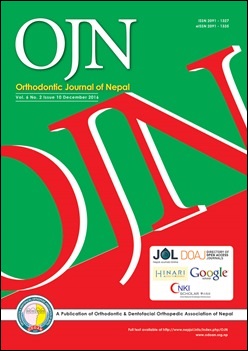Comparison of Reproducibility of Nasolabial Angle Constructed by Anatomic point method and Tangent line method
DOI:
https://doi.org/10.3126/ojn.v6i2.17415Keywords:
anatomic point method, lateral cephalogram, nasolabial angle, tangent line methodAbstract
Introduction: Investigators have drawn nasolabial angle using different soft tissue landmarks. This has created confusion among the orthodontic students and clinicians regarding its construction.
Objective: To evaluate two commonly used methods of constructing the nasolabial angle in order to establish a single reproducible method. Materials & Method: Lateral cephalograms of 120 patients undergoing orthodontic treatment were obtained from the records of the patients. Soft tissue profile on the lateral cephalograms were traced manually by the principal investigator. All the tracings were photocopied and 6 copies of each tracing were made. Nasolabial angles were constructed and measured on photocopied copies of the tracings first using the anatomic point method and then using the tangent line method by the principal investigator and another investigator independently.
Result: The average nasolabial angle values for anatomic point method and tangent line method were found to be 94.32° ± 14.05° and 92.4° ± 14.59° respectively. The intra-class correlation coefficient demonstrated excellent intra-observer and interobserver agreement among the two methods of nasolabial angle construction.
Conclusion: Both anatomic point method and tangent line method of nasolabial angle construction have excellent reproducibility in terms of intra-observer and inter-observer agreement.
Downloads
Downloads
Published
How to Cite
Issue
Section
License
Copyright © held by Orthodontic & Dentofacial Orthopedic Association of Nepal
- Copyright on any research article is transferred in full to the Orthodontic & Dentofacial Orthopedic Association of Nepal upon publication in the journal. The copyright transfer includes the right to reproduce and distribute the article in any form of reproduction (printing, electronic media or any other form).
- Articles in the Orthodontic Journal of Nepal are Open Access articles published under the Creative Commons CC BY License (https://creativecommons.org/licenses/by/4.0/)
- This license permits use, distribution and reproduction in any medium, provided the original work is properly cited.




